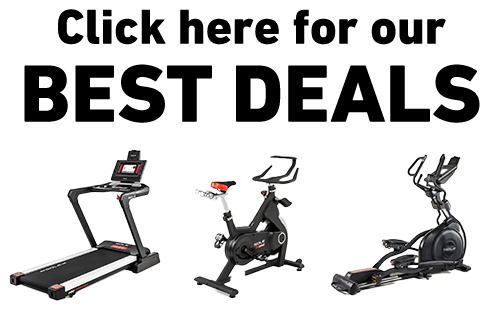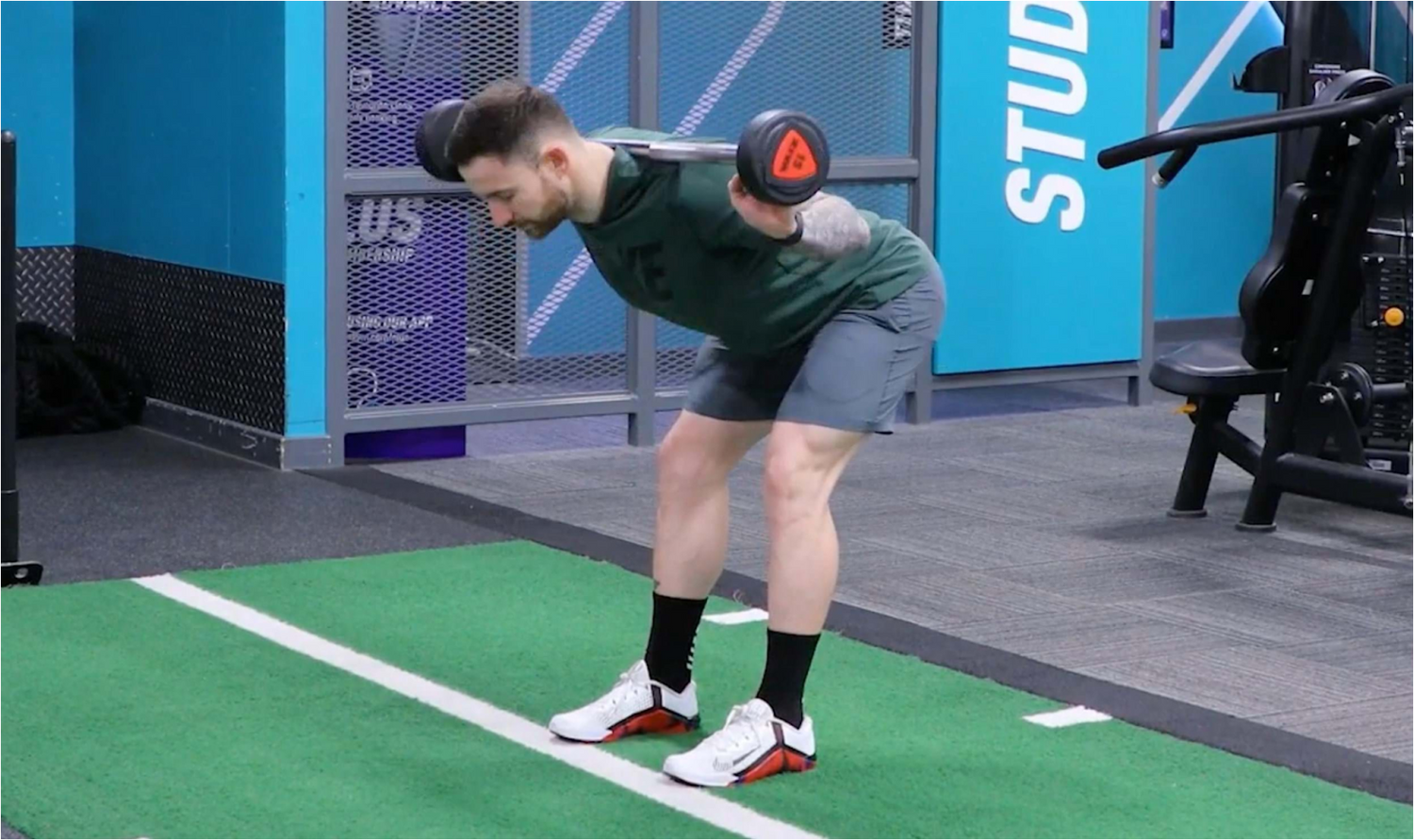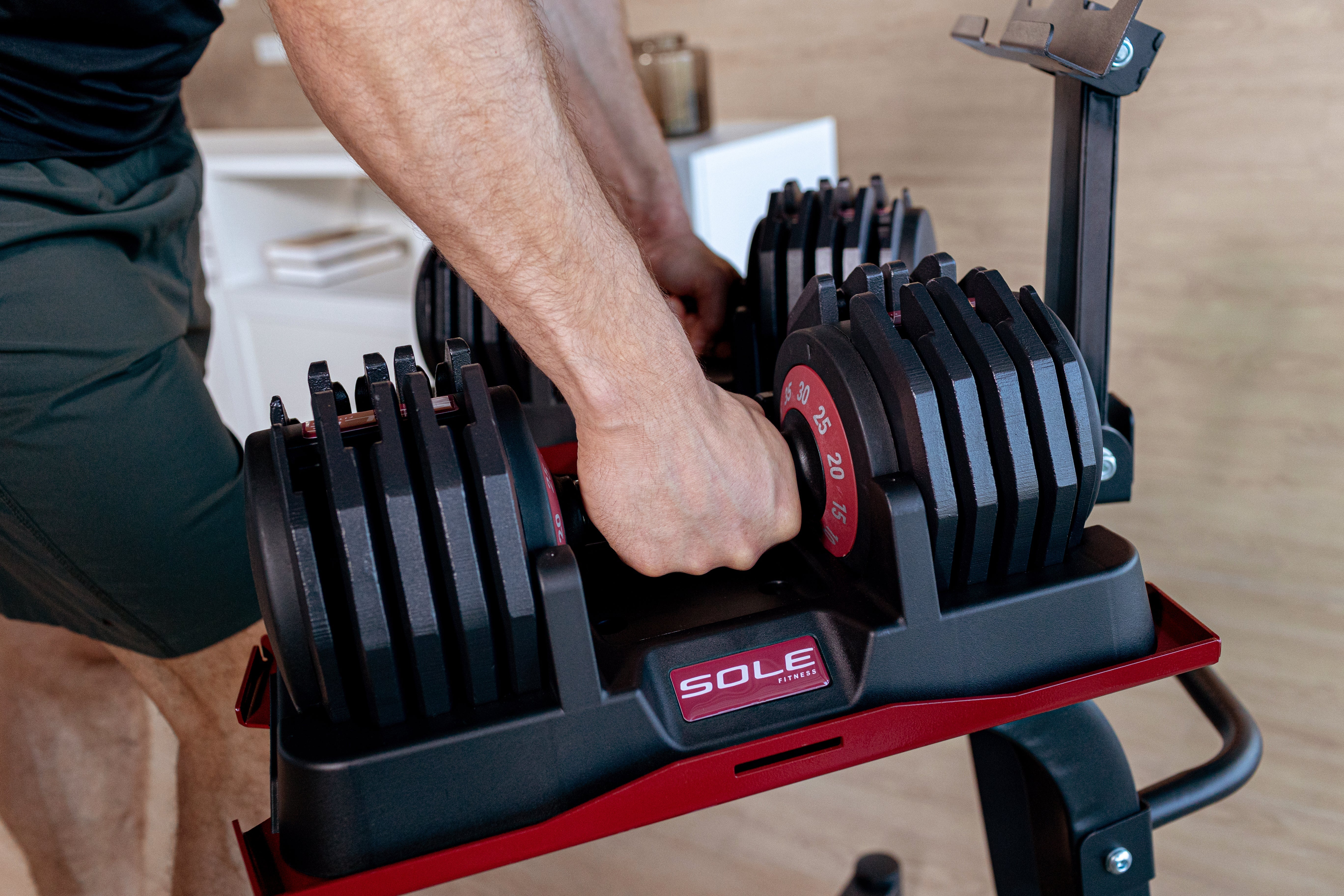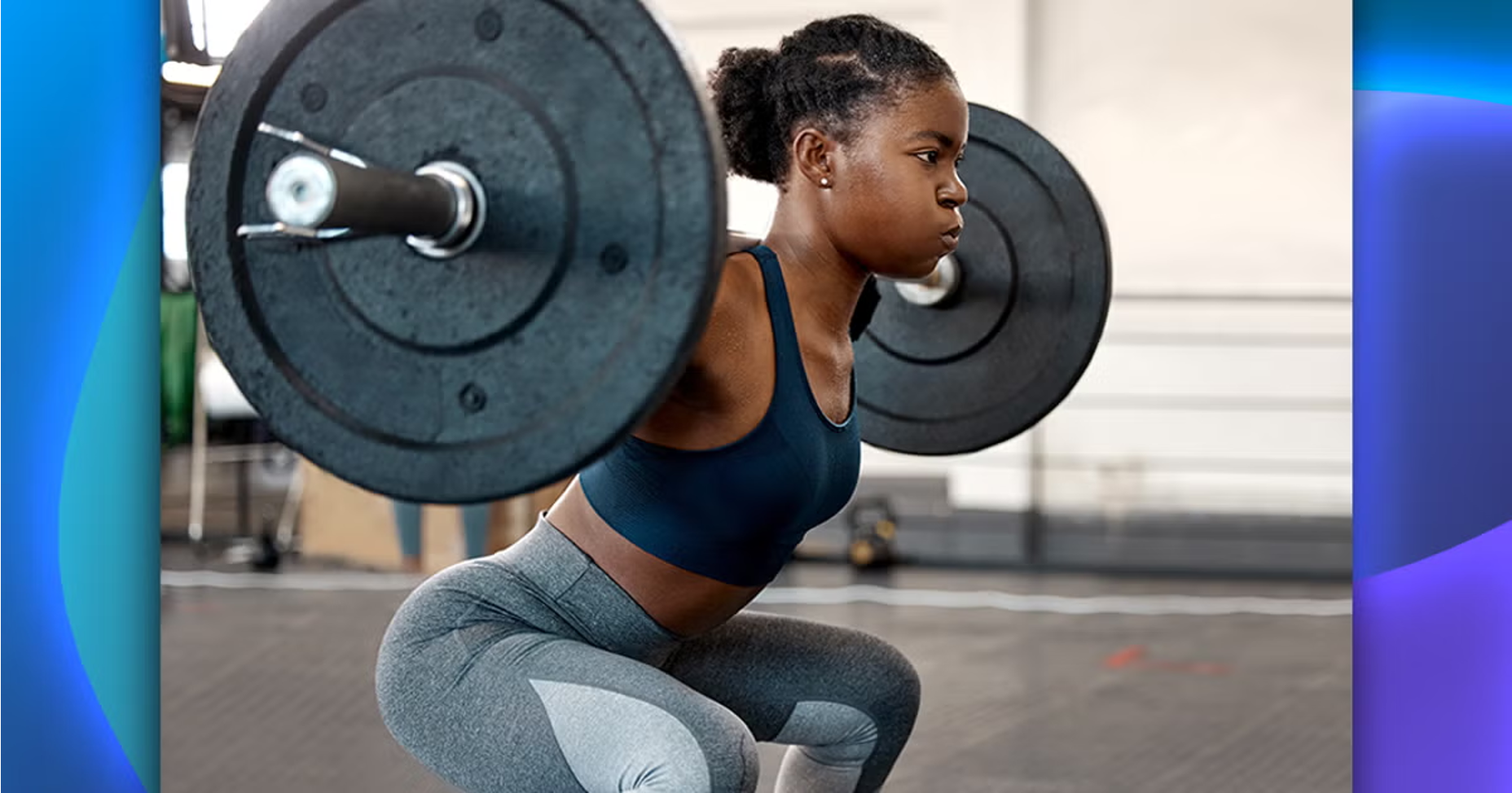Key Takeaways
- Good Mornings focus more on the lower back and glutes, while Romanian Deadlifts (RDLs) work hamstrings and glutes.
- Good Mornings use a barbell on your upper back, whereas RDLs require you to hold the barbell in front of you.
- Both exercises strengthen the posterior chain but target slightly different muscle groups.
- Choosing between them depends on your fitness goals and any physical limitations you might have.
- SOLE premium strength equipment enhances both Good Mornings and Romanian Deadlifts through perfectly balanced weight distribution, secure grip surfaces, and precise incremental loading
What Are Good Mornings and Romanian Deadlifts?
What are Good Mornings?
Good Mornings are essentially you bowing like you're greeting royalty, but with a barbell across your shoulders. You place the weight on your upper back (just like a squat), then bend forward at the hips until your torso is nearly parallel to the floor.
The name comes from the movement resembling an old-fashioned formal bow, like you're saying "good morning" to someone important. Except instead of being polite, you're building a bulletproof lower back and glutes.
What are Romanian Deadlifts?
Romanian Deadlifts (RDLs) involve holding a barbell in front of your thighs, then hinging at the hips to lower the weight down your legs while keeping your back flatter than a pancake. You should feel your hamstrings stretching like rubber bands as you lower the weight.
Despite the name, there's debate about whether this exercise actually originated in Romania. It's associated with Romanian Olympic lifter Nicu Vlad, but the exact origin story aren’t very clear.
|
At SOLE, we're proud to offer the best exercise equipment for your home or gym. Our machines are built to meet the highest quality and performance standards, making them perfect for fitness enthusiasts at any level. SOLE Products
|
Key Differences
Technique and Form Differences
In Good Mornings, the bar sits on your upper back, turning you into a human lever. This placement cranks up the intensity on your spinal erectors (those muscles running along your spine).
For RDLs, you hold the bar in front of you with straight arms. This shifts the focus to your hamstrings and takes some pressure off your lower back. It's generally more comfortable for people with cranky shoulders or backs.
Range of Motion
Both exercises use a hip hinge (bending at the hips while keeping your back straight), but with subtle differences:
Good Mornings involve a more limited range of motion; you typically stop when your torso is parallel to the floor. The focus is on controlling that heavy bar that's trying to fold you in half.
RDLs allow for a deeper stretch as you lower the bar further down your legs. You're chasing that hamstring stretch, which means you'll generally bend over more than in Good Mornings.
In Good Mornings, the barbell rests on your upper back, similar to a squat position. In Romanian Deadlifts, you hold the barbell in front of you, which can be more comfortable for those with shoulder or back issues. (Image courtesy of Men’s Health)
Grip and Equipment
With Good Mornings, your hands are just keeping the bar from rolling off your back. Your grip strength isn't really tested.
RDLs, however, require you to hold onto that bar for dear life. Your forearms get a serious workout, and grip strength can become a limiting factor.
Muscles Worked
Muscles Engaged in Good Mornings
The star of the Good Morning show is your lower back (erector spinae). These muscles work overtime to keep your spine from folding as you bend forward.
Your glutes and hamstrings join the party too, but they're more like supporting actors while your lower back gets the Oscar.
Muscles Engaged in Romanian Deadlifts
RDLs put your hamstrings center stage. That stretch you feel as you lower the bar? That's your hamstrings lengthening under tension, the secret sauce for building stronger, more flexible hammies.
Your glutes fire hard during the lifting phase, making RDLs a certified booty-builder. Your lower back still works, but it's more of a stabilizer than the main mover.
The RDL bonus round includes your forearms (from gripping), upper back, and even your calves as stabilizers. It's a more comprehensive exercise in terms of total muscle recruitment.
Exercise Benefits
Benefits of Good Mornings
If you've ever thrown out your back picking up a pencil, Good Mornings are for you. They build a bombproof lower back by strengthening those spinal erectors that keep you upright.
They're also killer for improving your squats and deadlifts. Many lifters hit plateaus in those exercises because of weak lower backs. Good Mornings directly address that weakness.
Another perk: they teach you proper hip hinge mechanics. Most back injuries happen because people bend at their spine instead of their hips. Good Mornings groove that hip hinge pattern under load.
Benefits of Romanian Deadlifts
If you want hamstrings that both look good in shorts and function well in sports, RDLs are your exercise. The stretched position under load is hamstring development gold.
For athletes, stronger hamstrings from RDLs can translate to faster sprinting and better jumping. Your hamstrings are crucial for explosive movements, which is why sprinters love this exercise.
RDLs also tend to be more accessible than Good Mornings. The bar position is less awkward for beginners, and many people find holding the weight in front more comfortable than balancing it on their back.
Shared Benefits
Both Good Mornings and Romanian Deadlifts share several benefits. They improve your posture by strengthening the muscles that support your spine. A strong posterior chain helps you maintain an upright posture in daily activities.
Choosing the Right Exercise
Good Mornings might be your go-to exercise if your primary goal is to strengthen your lower back and improve hip hinge mechanics. (Image courtesy of Inspire US)
Personal Fitness Goals
If your main goal is bulletproofing your lower back or improving your squat, Good Mornings get the edge.
If you're chasing hamstring development, athletic performance, or a more impressive backside, RDLs might be your best bet.
For overall posterior chain development, either exercise works well, but RDLs tend to be more beginner-friendly.
Physical Limitations Considerations
Got shoulder mobility issues? The bar position in Good Mornings might be uncomfortable. RDLs might be the better choice.
Lower back problems? Start with lighter RDLs, as Good Mornings put more direct stress on the lumbar spine.
Grip strength limitations? Good Mornings might be easier since you're not actually holding the weight with your hands.
Form Tips for Safe Lifting
Incorrect form technique in both Good Mornings and Romanian Deadlifts can lead to injuries, so it's important to focus on your form every time you lift. (Image courtesy of Jeff Nippard)
Proper Form for Good Mornings
- Start with the bar on your upper back, not your neck. If it's resting on your cervical spine, you're asking for trouble.
- Keep a slight bend in your knees throughout the movement. Locked knees put extra stress on your hamstrings and lower back.
- Maintain a neutral spine from start to finish. The moment your lower back rounds, you're in the danger zone.
- Start with a weight that feels too light. Your ego will recover faster than your herniated disc.
- Think about pushing your butt back toward the wall behind you rather than just bending over.
Proper Form for Romanian Deadlifts
- Start with the bar against your thighs, not out in front of your body. The bar should stay close to your legs throughout the movement.
- Keep your shoulders pulled back and down. The moment they round forward, your lower back is at risk.
- Lower the bar only as far as your hamstring flexibility allows. For some, that's mid-shin; for others, it's just below the knees. Don't force it.
- Drive your hips forward to stand up, squeezing your glutes at the top.
- Maintain a slight bend in your knees throughout. Completely straight legs put extra stress on your lower back.
Common Mistakes to Avoid
- Rounding your lower back is the cardinal sin in both exercises. This shifts stress from your muscles to your spine's discs and ligaments, which isn’t what you want.
- Using momentum to swing the weight up defeats the purpose and increases injury risk. These are controlled movements, not ballistic ones.
- Looking up or down excessively throws off your spine alignment. Keep your neck in a neutral position, in line with your back.
- Starting too heavy is the express route to Injury Town. Master the movement pattern with lighter weights before challenging yourself.
Master These Moves with SOLE Premium Strength Equipment
Ever tried to do RDLs with a bent bar? It's like trying to perform surgery with a butter knife: frustrating and potentially dangerous. SOLE SW111 Olympic Barbell eliminates this problem with its 194,000 PSI tensile strength that keeps it straight even during your heaviest sets. The specialized knurling provides secure grip for RDLs without tearing up your hands, which is critical when grip fatigue can limit your training.
SOLE SW111 Olympic Barbell provides the perfect balance and grip for both Good Mornings and Romanian Deadlifts.
Not ready for a barbell yet? The SW180 Adjustable Dumbbells let you master both movements with perfect form before graduating to the bar. Dumbbell Good Mornings and RDLs are excellent starting points, allowing for a natural range of motion that helps you feel the right muscles working. With weights adjustable from 5–80 lbs, you'll never outgrow them as your strength improves.
For those with back concerns, the SOLE SRVO All-in-One Trainer offers a guided motion path that helps ensure proper form during these technical exercises. Its adjustable resistance can be increased in 1-lb increments, giving you precise control over your progression without the intimidation factor of loading plates onto a barbell.
The SOLE+ App provides step-by-step tutorials showing exactly how to perform both exercises with perfect form. You'll learn proper hip hinge mechanics, optimal foot placement, and how to maintain that crucial neutral spine position throughout each movement.
What makes SOLE equipment perfect for these exercises is the quality difference you'll notice immediately. The balanced weight distribution of both the barbell and dumbbells eliminates the wobbling that often leads to form breakdown during Good Mornings and RDLs.
Check out the complete SOLE equipment strength collection!
Frequently Asked Questions (FAQs)
Are Good Mornings safe for beginners?
Good Mornings aren't inherently dangerous, but they're less forgiving of poor form than many exercises. Beginners should start with bodyweight Good Mornings or very light weights and possibly seek coaching. RDLs tend to be more beginner-friendly, so if you're new to lifting, you might want to master those first.
How does grip impact RDL performance?
A strong grip allows you to focus on the movement without worrying about dropping the weight. Using lifting straps can help if grip strength is a limiting factor.
Can these exercises replace squats?
While Good Mornings and Romanian Deadlifts are excellent for the posterior chain, they don't fully replace squats. Squats engage a broader range of muscles, including the quadriceps. Incorporating all three exercises can provide a balanced lower body workout.
What weight should I start with?
Start with a weight that allows you to perform 8–12 reps with good form. It's better to begin with a lighter weight and focus on technique before gradually increasing the load.
Which SOLE Equipment works best for learning these exercises?
For beginners, the SW180 Adjustable Dumbbells are perfect for learning the hip hinge pattern safely. Start with lighter weights (10–20 lbs) to master the movement before progressing. Their balanced weight distribution helps maintain proper form during the learning phase. Once you're comfortable with the movement, the SW111 Olympic Barbell provides the ideal platform for both exercises with its secure grip and stability under load.







Leave a comment
This site is protected by hCaptcha and the hCaptcha Privacy Policy and Terms of Service apply.